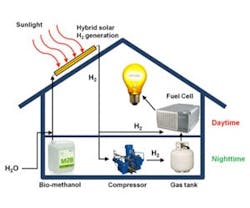Solar Efficiencies Improved by Water and Methanol
While roofs across the world sport PV solar panels, one expert believes a hybrid system with methanol and water can improve solar cell efficiencies.
Nico Hotz, a Duke University engineer, proposes a system where sunlight heats a combination of water and methanol in a maze of copper tubes coated with a thin layer of aluminum and aluminum oxide and partly filled with nanoparticles.
After two catalytic reactions, the system produces hydrogen more efficiently than current technology and without significant impurities. The resulting hydrogen can then be stored and used on demand in fuel cells.
“This set-up allows up to 95% of the sunlight to be absorbed with very little being lost as heat to the surroundings,” Hotz says. “This is crucial because it permits us to achieve temperatures of well over 200 degrees C. within the tubes. By comparison, a standard solar collector can only heat water between 60 and 70 degrees C.”
While costs and efficiencies can vary widely, a rooftop system large enough to supply all of a building’s electrical needs in winter would produce more energy than needed in summer. This allows an owner to decide whether to shut down portions of the rooftop structure or, if possible, sell excess energy back to the grid.
This could be an important consideration, especially if a structure is located in a remote area where traditional forms of energy are too difficult or expensive to obtain.
